RECOVERY
Religion
Christianity
Jesus Christ and the Story of Easter
"After Jesus was crucified, Joseph of Arimathea had Christ's body placed in his own tomb. A large stone covered the entrance and soldiers guarded the sealed tomb. On the third day, a Sunday, several women (Mary Magdalene, Mary the mother of James, Joanna and Salome are all mentioned in the gospel accounts) went to the tomb at dawn to anoint the body of Jesus.
A violent earthquake took place as an angel from heaven rolled back the stone. The guards shook in fear as the angel, dressed in bright white, sat upon the stone. The angel announced to the women that Jesus who was crucified was no longer in the tomb, "He is risen, just as he said." Then he instructed the women to inspect the tomb and see for themselves. Next he told them to go inform the disciples.
With a mixture of fear and joy they ran to obey the angel's command, but suddenly Jesus met them on their way. They fell at his feet and worshiped him. Jesus then said to them, "Do not be afraid. Go tell my brothers to go to Galilee. There they will see me." When the guards reported what had happened to the chief priests, they bribed the soldiers with a large sum of money, telling them to lie and say that the disciples had stolen the body in the night.
After his resurrection, Jesus appeared to the women near the tomb and later at least twice to the disciples while they were gathered at a house in prayer. He visited two of the disciples on the road to Emmaus and he also appeared at the Sea of Galilee while several of the disciples were fishing."
- Quoted directly from http://christianity.about.com/od/biblestorysummaries/p/theresurrection.htm
In this famous Biblical story, the spirit of Jesus Christ was resurrected after being crucified by the Romans. To celebrate the recovery of Jesus's spirit and the sacrifice that he had made for the Christian faithful, the holiday of Easter is celebrated on the first Sunday after the first full moon on or after March 21st.
The Cross
The Christian Cross is one of the earliest and most used symbols in Christianity. The Cross represents the death of Jesus. The common Cross is called the Latin Cross. The empty cross reminds Christians of the ressurection of Christ. The crucifix is a reminder of the actual sacrifice. The first Christian Cross invented was the Greek Cross which has four arms with equal lengths.
The Story of Job
Job was a very prosperous man that owned a wide range of livestock and many children. Job always humbled himself to God and kept his faith, no matter how hard his trials were. One day, Satan challenged Job's unwavering faith, claiming that he was only faithful because of all of his material riches. God agreed to the "bet" and allowed Satan to wreak havoc on his life. Job’s wealth, children and health were all destroyed. Despite his extremely difficult situation and the poor advice of his friends, Job did not curse God and never accused God for the injustice. In the end, it was clear that Job would never betray God, and the Lord descended to the faithful man and ended his trials. Job was restored to health and gained double of what he had lost in possessions, as well as his entire family.
Not only is Job the ideal model for a devout and faithful Christian, he embodies an inspiring story of loss and recovery. Although he was devastated by the loss of his children, wealth, and health, Job remained mentally and emotionally strong enough to survive God's trials. By staying faithful to God, Job recovers all that he had lost plus more as a reward.
"After Jesus was crucified, Joseph of Arimathea had Christ's body placed in his own tomb. A large stone covered the entrance and soldiers guarded the sealed tomb. On the third day, a Sunday, several women (Mary Magdalene, Mary the mother of James, Joanna and Salome are all mentioned in the gospel accounts) went to the tomb at dawn to anoint the body of Jesus.
A violent earthquake took place as an angel from heaven rolled back the stone. The guards shook in fear as the angel, dressed in bright white, sat upon the stone. The angel announced to the women that Jesus who was crucified was no longer in the tomb, "He is risen, just as he said." Then he instructed the women to inspect the tomb and see for themselves. Next he told them to go inform the disciples.
With a mixture of fear and joy they ran to obey the angel's command, but suddenly Jesus met them on their way. They fell at his feet and worshiped him. Jesus then said to them, "Do not be afraid. Go tell my brothers to go to Galilee. There they will see me." When the guards reported what had happened to the chief priests, they bribed the soldiers with a large sum of money, telling them to lie and say that the disciples had stolen the body in the night.
After his resurrection, Jesus appeared to the women near the tomb and later at least twice to the disciples while they were gathered at a house in prayer. He visited two of the disciples on the road to Emmaus and he also appeared at the Sea of Galilee while several of the disciples were fishing."
- Quoted directly from http://christianity.about.com/od/biblestorysummaries/p/theresurrection.htm
In this famous Biblical story, the spirit of Jesus Christ was resurrected after being crucified by the Romans. To celebrate the recovery of Jesus's spirit and the sacrifice that he had made for the Christian faithful, the holiday of Easter is celebrated on the first Sunday after the first full moon on or after March 21st.
The Cross
The Christian Cross is one of the earliest and most used symbols in Christianity. The Cross represents the death of Jesus. The common Cross is called the Latin Cross. The empty cross reminds Christians of the ressurection of Christ. The crucifix is a reminder of the actual sacrifice. The first Christian Cross invented was the Greek Cross which has four arms with equal lengths.
The Story of Job
Job was a very prosperous man that owned a wide range of livestock and many children. Job always humbled himself to God and kept his faith, no matter how hard his trials were. One day, Satan challenged Job's unwavering faith, claiming that he was only faithful because of all of his material riches. God agreed to the "bet" and allowed Satan to wreak havoc on his life. Job’s wealth, children and health were all destroyed. Despite his extremely difficult situation and the poor advice of his friends, Job did not curse God and never accused God for the injustice. In the end, it was clear that Job would never betray God, and the Lord descended to the faithful man and ended his trials. Job was restored to health and gained double of what he had lost in possessions, as well as his entire family.
Not only is Job the ideal model for a devout and faithful Christian, he embodies an inspiring story of loss and recovery. Although he was devastated by the loss of his children, wealth, and health, Job remained mentally and emotionally strong enough to survive God's trials. By staying faithful to God, Job recovers all that he had lost plus more as a reward.
Judaism
Yom Kippur is one of the most important holidays in Judaism. Yom Kippur is celebrated on the 10th of Tishri. The three essential components of Yom Kippur are: repentence, prayer, and fasting. Yom Kippur is the day when Jews ask for forgiveness from their sins that year. God judges you based on your behavior, either placing your name in the book of life or the book of death. Yom Kippur is the last day God can change his judgement. Yom Kippur is a day of reconciliation. The ten days prior to Yom Kippur, Jews seek out anyone they have offended to sincerely request forgiveness so that the New Year can begin with a clean slate. The services on Yom Kippur are the longest services in the Jewish year. During these long services, we pray for forgiveness from God. After the services, many Jews throw pieces of bread into a body of water, each one representing a sin they are throwing away. Fasting is the most difficult part of Yom Kippur. After you have a Bar/Bat Mitzvah, you are required to fast. Yom Kippur is a 25 hour fasting period. You are not allowed to eat or drink anything, including water. People who are sick, pregnant, or have a life-threatening illness are not required to fast on this day.
Ancient Greek Mythology
The Health Deities
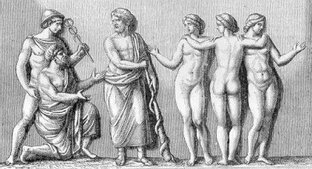
Apollo (left), Asclepius (center), and Asclepius's daughters (right)
Asclepius, the Greek god of medicine and healing, and Epione, the goddess of soothing of pain, have five daughters that each represent an aspect of healing: Aceso the goddess of recovery, Iaso the goddess of recuperation, Hygieia the goddess of disease prevention, Aglaea the goddess of natural beauty, and Panacea the goddess of cures. The modern definition of the word panacea is "a remedy believed to cure all diseases and prolong life." The search for a mythical panacea was an aspect of the ancient study of alchemy.
The health deities were worshipped by the ancient Greeks in sacred sanctuaries as a method of alleviating the sick. The cult (believers) of Asclepius were composed of priests that congregated in centers known as Asclepieia. The Aclepieia became very popular during the 300s BC as pilgrims eagerly flocked to be cured of their diseases.
The health deities were worshipped by the ancient Greeks in sacred sanctuaries as a method of alleviating the sick. The cult (believers) of Asclepius were composed of priests that congregated in centers known as Asclepieia. The Aclepieia became very popular during the 300s BC as pilgrims eagerly flocked to be cured of their diseases.
The Staff of Asclepius
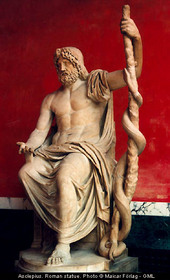
The rod that the ancient Greek god Asclepius carries, depicted as a serpent entwined around a staff, is known as the Staff of Asclepius. This staff is the dominant symbol for healthcare and medicine in the United States. It can be found being utilized by many professionals and organizations. Examples of organizations that use the Staff of Asclepius as their logo, or part of their logo, include the American Medical Association, United States Navy Hospital Corps, and the United States Air Force Medical Corps (click here for an extended list). The caduceus is often mistakingly used as a medical symbol in place of the Staff of Asclepius.
The Caduceus
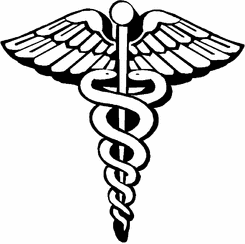
The caduceus is the traditional symbol of the Greek god Hermes, featuring two snakes around a winged staff. It is often mistakenly used as a symbol of medicine, especially in the United States. Association of the caduceus with medicine can be traced to the Renaissance, where it was often associated with alchemy and wisdom.
The "medical significance" of the caduceus appears to have arisen as a result of widespread confusion in the United States. The caduceus had appeared on the chevrons of Army hospital stewards as early as 1856. It is likely that this was a result of ignorance or misinterpretation regarding the designation of the rod of Asclepius.
Famous Mythology
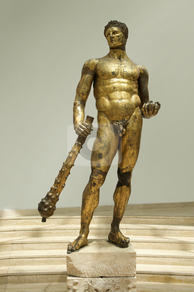
Hercules is considered the greatest and most famous of all Greek mythological heroes. According to legend, Hercules was the son of Zeus and a mortal woman, possessing superhuman strength since his birth. After he grew up to be an athletic and accomlished man, Hercules was driven mad by the goddess Hera and indiscriminately killed his own two children. After coming to his sense, Hercules was appalled by his heinous murders. To atone for his crime, Hercules was sentenced to perform twelve impossible tasks, or "Labors", for his cousin Eurystheus, the king of Tiryns and Mycenae. The great Greek hero managed to heroically defeat seemingly invulnerable monsters, including the Lion, the Hydra, and a hundred headed dragon. By the end of these labors, Hercules restored his honor that was lost by murdering his own children, and became Greek's greatest hero in the process.
Another famous myth involves the hero Theseus and his slaying of a monster called the Minotaur. When Theseus entered the Labyrinth where the Minotaur lived, he was given a ball of yarn by a young maiden named Ariadne. Theseus was able to unwind the yarn as he walked to mark his route within the twisting-and-turning maze. Once he found the Minotaur and killed it, Theseus used the string to find his way out of the maze. Theseus was able to recover his orientation and retrace his steps in the Labyrinth to emerge safely after his incredible feat.
Another famous myth involves the hero Theseus and his slaying of a monster called the Minotaur. When Theseus entered the Labyrinth where the Minotaur lived, he was given a ball of yarn by a young maiden named Ariadne. Theseus was able to unwind the yarn as he walked to mark his route within the twisting-and-turning maze. Once he found the Minotaur and killed it, Theseus used the string to find his way out of the maze. Theseus was able to recover his orientation and retrace his steps in the Labyrinth to emerge safely after his incredible feat.
Monsters
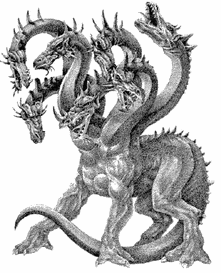
The stench and venom from the monstrous Hydra were deadly enough to kill men and beasts. The Hydra had the body of a serpent with one head that could never be harmed by any weapon. It had many other heads that, if severed, two would grow in its place. The ability of the Hydra to regenerate its heads made it a very formidable opponent.
The legendary Greek hero Hercules journeyed to Lake Lerna in search of the dreaded Hydra. Hercules managed to kill the monster by cutting off the heads one by one from the Hydra, and sealing the open wounds with a flaming torch. With the one remaining head that could not be harmed by any weapon, Hercules tore it off with his bare hands and quickly buried it deep in the ground, placing a huge boulder on the top. Hercules had accomplished the incredible task of killing a monster that was able to perpetually recover from its wounds.
The legendary Greek hero Hercules journeyed to Lake Lerna in search of the dreaded Hydra. Hercules managed to kill the monster by cutting off the heads one by one from the Hydra, and sealing the open wounds with a flaming torch. With the one remaining head that could not be harmed by any weapon, Hercules tore it off with his bare hands and quickly buried it deep in the ground, placing a huge boulder on the top. Hercules had accomplished the incredible task of killing a monster that was able to perpetually recover from its wounds.
Sources
http://everydaychristian.com/blogs/post/the_story_of_job_faith_under_trial/http://en.wikipedia.org/wiki/List_of_Greek_mythological_figures#Health_deities
http://www.pantheon.org/articles/a/asclepius.html
http://en.wikipedia.org/wiki/Panacea_(medicine)
http://www.martialdevelopment.com/wordpress/wp-content/images/hermes-asclepius-and-graces.jpg
http://www.perseus.tufts.edu/Herakles/bio.html
http://watermarked.cutcaster.com/cutcaster-photo-100124645-Hercules-statue.jpg
http://www.pantheon.org/articles/h/hydra.html
http://www.hydrarocks.com/images/hydra.gif
http://www.gospel-mysteries.net/crucifixion-jesus.html
http://www.christianet.com/holidays/wheniseastercelebrated.htm
http://www.religionfacts.com/christianity/symbols/cross.htm
http://judaism.about.com/od/holidays/a/yomkippur.htm